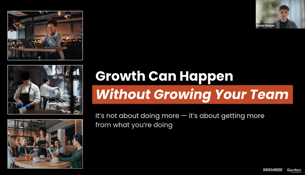Whether you’re opening your first spot or managing several, knowing how to do marketing for restaurants isn’t just about catchy ads or Instagram posts. It’s about knowing what data to track – and how to act on it – for where you are in your growth journey.
While time and resources are in short supply for restaurant operators and chefs, the right marketing approach moves you from being reactive to proactive, and from surviving to thriving.
This blog breaks it down and guides you on making the most of the resources you put into your marketing efforts.
Starting Out: Free Tools and Foundational Data
For new restaurants just getting started, you’re not exactly working with a giant pool of data revealing what moves to make. Likewise, a common challenge is that time and budget are often limited – operators and chefs are too busy running the business to do much marketing.
The goal when you’re starting out is to build early momentum. Early stage marketing is more than just tracking costs and sales. Start collecting basic customer data like reviews and social media activity. There are simple, free tools and tactics to help.
To start:
- Track your reviews on Google, Yelp, and TripAdvisor. Look for trends in feedback, common complaints, and praise.
- Monitor social media followers and engagement. These folks are showing interest, so watch what content they like, comment on, and share.
- Respond to reviews, especially on Google, which influences SEO. SEO stands for “search engine optimization,” and it refers to using elements in your website that show you’re providing useful, relevant information. The ultimate goal is to make sure your restaurant shows up high on the list when customers google something like “best burgers near me.” Responding to reviews boosts visibility and trust, which helps your SEO.
Early on, I recommended that you skip purchasing expensive platforms like advanced CRM (customer relationship management) systems, paid ad managers, or analytical tools. Instead, use your POS (point of sale) system to gather customer data like visit frequency, what menu items are popular, and the average spend.


Subscribe to Our Monthly Marketing Newsletter
Get proven strategies and tools to attract new customers, boost engagement, and grow your brand.
These small steps create the foundation for later efforts, such as email marketing with segmentation – sending targeted emails to specific groups of customers based on their behavior. If you target groups like frequent diners or first-timers, your messages are relevant and effective.
If you’re ready to get hyper-focused, there are social platforms like Sprout Social and Neighbourhood Networks to make managing the social promotional side of your restaurant much easier.
Growth Stage: Making Marketing Work Harder
After the honeymoon period fades (which could be weeks to a few months), most restaurants see a natural dip in business. That’s when many operators start exploring paid marketing to prompt customers to return and reach new audiences.
The risk now is throwing money at tools disconnected from one another or tools that require too much manual effort to make meaning out of the data.
At this stage, your top three priorities are to:
- Make sure you have a simple website (Flavor Plate is an affordable way to build one) to anchor your online presence — a Facebook page isn’t enough.
- Use integrated tools like Owner or ChowNow to consolidate customer and campaign data.
- Invest in loyalty programs that prompt return visits.
When adding new tools, the main goal is to avoid data silos – separate batches of data stored so you can’t see how different actions affect each other. So make sure you choose platforms that integrate well with each other.
You also want tools with user-friendly dashboards that present clear, actionable data, so you’re never overwhelmed by numbers and can take action with just a click or two.
Scaling Up: Multi-Location Data Challenges
When your restaurant grows to multiple locations, marketing becomes more complex, especially when the platforms previously supporting restaurant marketing efforts don’t evolve alongside this growth.
Some common marketing challenges for restaurants at this expansion stage include no shared dashboard for performance metrics, fragmented or old tech that simply doesn't integrate, and inconsistent brand voice across locations.
At this point, you’ll want to review your tech stack to make sure you’re using what’s there. If you’re not, see if it’s useful — or just get rid of it.
Marketing for restaurants at this stage requires scalable tools. Look for platforms that provide:
- Centralized dashboards that track key metrics like sales and costs across all locations in one place
- AI-driven campaign suggestions that use artificial intelligence to analyze customer data. You can use these suggestions to create personalized campaigns to boost customer loyalty. (Loyalist has this feature.)
- Cloud-based POS systems that support segmentation. As mentioned above, segmentation uses customer data to target offers and improve marketing.
These are marketing keys to driving sustained growth for your restaurants. At this point in the evolution of your business, you may have all the tools in the world, but they have to be integrated and speak to one another.
Mature Businesses: Using Data to Drive Strategy
Even well-established restaurants can hit a wall. Maybe sales are steady, but growth has stalled. That’s often a sign of hidden inefficiencies, and the best way to spot them is by digging into your data.
At this level, marketing isn’t just about promotions – it’s about strategic decisions based on customer data. If you’ve got an all-in-one POS system like Toast, you can use the information it provides to create a growth plan that covers everything from staffing to expansion.
- Sales and customer data can guide hiring, menu design, and inventory. It can show you what’s working – what’s selling, when you're busiest, and where things are slowing down. That info helps you make smarter calls on staffing, inventory, and what menu items stay or go.
- Data about customer churn — the rate at which you lose old customers and gain new ones — can highlight where you’re losing customers and suggest ways to re-engage, for instance by doing a win-back campaign or offering fresh loyalty perks.
- Marketing insights can help showcase the positive things about your business and staff. They don’t just help bring in customers. You can use them to show off your dedicated team and culinary culture in a way that helps attract top talent.
Looking Ahead: Data for Visionary Moves
Forward-thinking restaurant owners use data to make bold, confident decisions. That might mean opening a new location, trying a new concept, or revamping the brand.
What data do you need for this?
- Demographic insights on who your customers are and where they come from
- Loyalty data that flags declining visits or identifies high-value customers
- Survey feedback to understand what brings people back
With insights like these, you’re turning data into a clear vision to spot new opportunities and take calculated risks.
Final Thoughts: Take Action on the Data You Have
The restaurant industry doesn’t need more data – it needs to make better use of the data that’s already available. Whether you’re in your first year or managing ten locations, the path to smarter marketing for restaurants starts with one question:
What do we already know, and what action can we take today?
If you’re wondering how to do marketing for restaurants at any stage, remember that with the right tools, systems, and mindset, data should be your guide, not just your scoreboard. Schedule your consultation today so we can review your current marketing needs and point you to the tools that are right for your stage of growth.





